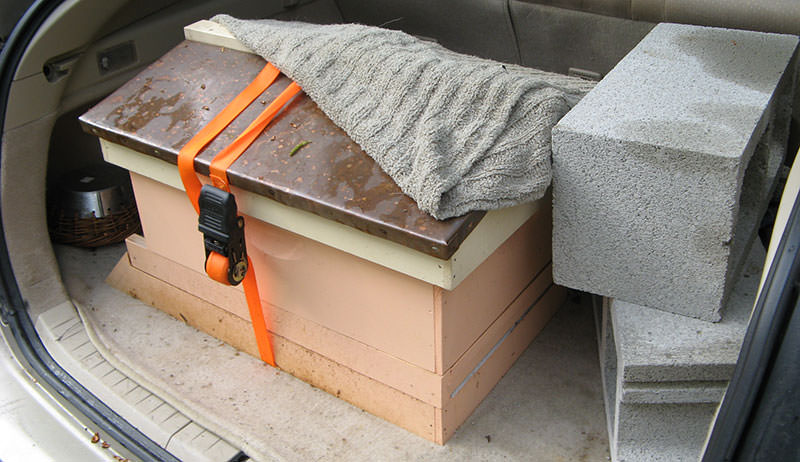
The many ways and reasons to move a hive are as varied as the beekeepers who move them. For large-scale commercial beekeepers, moving hives is essential to pollination and production, but the way you move hives as a small-scale hobbyist differs in scale and technique.
Why Move a Hive?
The general rule is to move a hive less than 3 feet, or more than a mile. The shorter distance takes into account drift from foraging bees. They’ve already oriented to the hive’s position, and a move of less than 3 feet in either direction will ensure they can still find their hive. A move of more than a mile ensures the bees will orient to the new position and be able to return to the hive. If a move is between those two distances, they will fail to reorient and get lost upon return.
Beekeepers usually move a hive for personal reasons. Sometimes we move houses or farms, while other times we purchase established hives from other beekeepers and aim to bring them home. In the beekeeping area where I live, it’s common for local beekeepers to sell established nucleus colonies (commonly called nucs), which need to be transported back to your apiary once purchased.
Hive-Moving Prep
Preparation for a hive move happens in two stages: beekeeper preparation and hive preparation.
Beekeeper Preparation
You need to establish certain things before even touching the hive. Set up the new location by putting hive stands in place, erecting electric fencing, and clearing and mowing the area if necessary. Fill the transportation vehicle with fuel so that once you’re loaded up, you can drive directly to the destination. Don’t stop if you can help it.
Some vehicles are better for transporting bees than others. Admittedly, I’ve moved bees in a flatbed truck, a family Subaru Forester and a tiny hatchback Toyota Prius—with varied degrees of success. Bees can “leak” from the hive even though it’s sealed, so if it’s inside a vehicle—as it was driving across town in my Prius—any bees that escape will instinctively fly toward the windows trying to find the light. A few leaked bees is not a disaster, but that depends on the kind of driver and beekeeper you are. Maybe keep the bee suit on in the car just in case.
As part of your beekeeper preparation, also have with you any equipment that’s critical to the move. This includes your smoker, bee suit, veil, a strap to tie down the hive, any screens to enclose the entrance or hive top, and a dolly, hand tractor or hive-moving equipment. Some beekeeping catalogs sell hive movers for one or two people. While this is an added cost, these can be beneficial to the small-scale beekeeper who routinely moves hives from one location to another.
Hive Preparation
Once your vehicles and locations are secured, you’re ready for hive preparation. Split the hive or reduce the weight of the hive if needed. Also, secure the hive with screens along the entrance and the top of the hive because ventilation is critical for stressed hives. Overheating can lead to melted comb, dead brood and injured bees. Finally, secure your hives in the vehicle with a strong, reliable nylon strap before moving.
Tips for Success
- If using a dolly or mover, tilt the hive backward. Side-to-side movement could cause frames to move and stack on one another, crushing bees and potentially the queen.
- Move the bees at daybreak. Commercial beekeepers move their hives at night, but bees can be defensive and aggressive at night. Secure your bees the night before the move, but arrange for the move to take place right at dawn, when the bees are calmer and you have adequate light.
- Split large hives into manageable supers to save your back. There are many ways to move a large established hive. You can take the move as an opportunity to split the hive and create two colonies, or you can remove frames of honey to lighten the load and replace them when you arrive at your destination.
- Consider the weather and distance of move. Wet bees are angry bees, and soggy beekeepers are grumpy movers. Plan your move for a clear day. Also prepare in accordance with the distance of your move: Long-distance moves should include ample screening for maximum ventilation and the ability for you to check on the bees and spray water on them if necessary. Shorter moves (travel time of less than 45 minutes) can usually be conducted with less fuss and potentially fewer screens, depending on the time of year the move takes place.
- Enlist the help of a friend. Even if you have small hives or a strong back, it’s good to have an extra set of eyes, ears and hands to help with the nice. At the very least, you’ll have company in the car for the drive.
Planning ahead goes a long way toward an effective hive move, but it’s really quite simple. As far as livestock go, bees are easy-going and compact in their housing, and they adapt well to new locations. Plan to move them in comfort and without delay so the transition will be easy and uneventful—very good things when it comes to honeybees.




